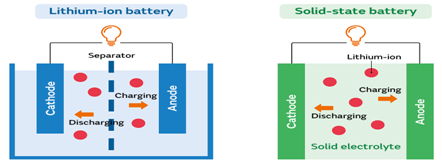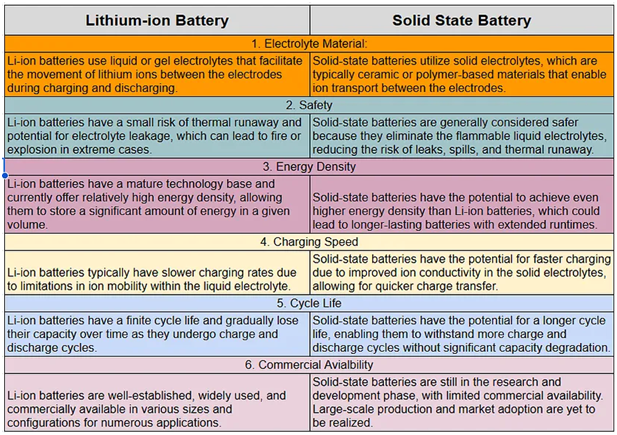Why in News?
- Japan’s Toyota Motor Corp, a late entrant into the battery electric vehicle race, is aiming to roll out next-generation solid-state batteries over the next three years.
- This will mark a milestone in the global race to commercialise this breakthrough technology that promises to double vehicle range and drastically lower charging time.
What’s in Today’s Article?
- What is a Solid-State Battery?
- Lithium-Ion Battery vs Solid-State Battery
- Advantage of the Solid-State Batteries
- Toyota’s Decision to Roll Out Next-Generation Solid-State Batteries
- Other Companies Making Progress on Alternatives to Li-Ion Batteries
- Issues with the Solid-State Batteries
What is a Solid-State Battery?
- A solid-state battery is essentially battery technology that uses a solid electrolyte instead of liquid electrolytes which are instead behind lithium-ion technology.
- It is therefore important to take a step back and understand how lithium-ion batteries work in detail and their main differences compared with this new technology.
Lithium-Ion Battery vs Solid-State Battery:


Advantage of the Solid-State Batteries:
- An advantage of solid-state batteries is that the electrolyte is solid. This allows ions, which convey electricity, to move faster.
- This enables shorter charging times, increased cruising ranges, and produces higher power output.
- Solid-state batteries are also characterised by being highly stable because they are resistant to changes in temperature and can robustly endure high temperatures and high voltages.
Toyota’s Decision to Roll Out Next-Generation Solid-State Batteries:
- Toyota, the world’s largest carmaker by vehicles sold, had announced a breakthrough in solid state battery materials late last year and had said it plans to mass-produce solid-state batteries by 2027 or 2028.
- In the due course, the Japanese carmaker could potentially have two sets of battery electric vehicles (BEVs) on offer across markets, including India –
- Existing lithium-ion (li-ion) batteries and
- New and pricier solid-state batteries.
- Solid-state batteries are seen as a major improvement in battery tech, countering concerns such as -
- Extended charging time and
- The risk of catching fire associated with traditional Li-ion batteries that have a liquid electrolyte.
- With its new solid-state batteries, Toyota expects its electric cars powered by them to have a range of 1,200km - well over twice that of the current range of EVs and a charging time of 10 minutes or less.
- This is far lower than two-four hours that it takes to fast charge an EV with Li-ion batteries.
Other Companies Making Progress on Alternatives to Li-Ion Batteries:
- Chinese battery maker CATL revealed in end-2023 that it was preparing to mass-produce its semi-solid batteries.
- South Korea’s Samsung SDI has completed a fully automated pilot line for solid-state batteries. Germany’s Volkswagen was reported to have held talks with France’s Blue Solutions, which already produces solid-state batteries for Daimler electric buses.
- Japan’s Toyota had announced a partnership with Tokyo-based petroleum company Idemitsu Kosan to jointly produce a solid-state battery material called sulphide solid electrolyte.
- Sulphide solid electrolytes are characterised by softness and adhesiveness to other materials, which is suitable for battery mass production.
- The collaboration is focussed on mass-production of new materials and establishing a supply chain for solid electrolytes, which hold the key to the commercialisation of solid-state batteries.
Issues with the Solid-State Batteries:
- A longstanding technical issue in solid state battery development has been that repeatedly charging and discharging the battery causes cracks between the cathodes and anodes and the solid electrolytes.
- This degrades battery performance.
- Producing solid-state batteries in large volumes is costly and difficult.
- Other problems include -
- The extreme sensitivity of the batteries to moisture and oxygen, as well as
- The mechanical pressure needed to hold them together to prevent the formation of dendrites, the metal filaments that can cause short circuits.









